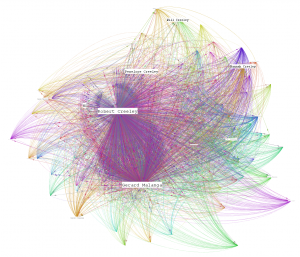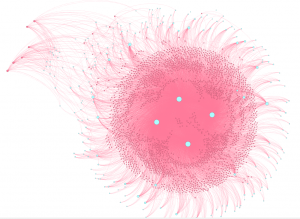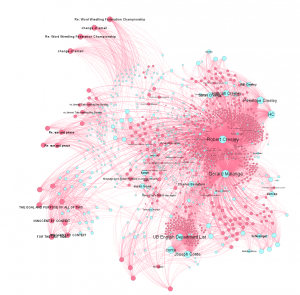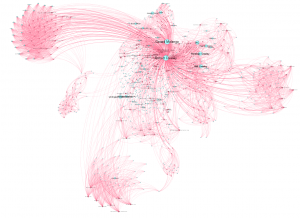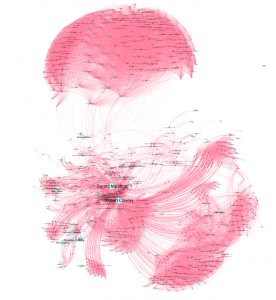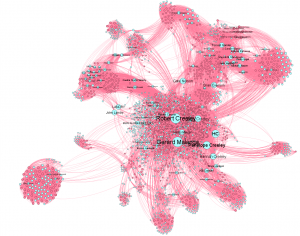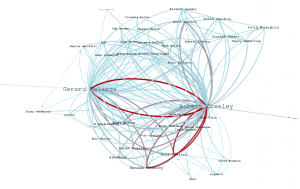Who: Elijah Meeks, with Peter Chan and the AIMS project
What: Robert Creeley’s Digital Correspondence Maps
When: Ongoing
Where: Stanford University, Palo Alto, CA.
“Open Door” features audio, video, and online media to document dynamic interactions between poetry and its audience. “Open Door” showcases performance, scholarship, and engagement outside the usual boundaries of slams, workshops, and book publications. This week: mapping Robert Creeley's correspondence. (click on the images to enlarge)
At first glance, one of the maps looks like an exploding galaxy— clusters of formative blue and black planets, pink comets ricocheting between, all spawning an abstract, pastel network. From a distance, another map looks like a piece of bisected coral put on a slide and magnified under a microscope, while another looks like a jellyfish hovering above a felled space alien.
These are Robert Creeley’s e-mails, or rather what some clever, digitally-inclined people at Stanford University have done to Robert Creeley’s e-mails. They’ve used software to diagrammatically represent human expression, from the correspondence of Voltaire and Benjamin Franklin to, most recently, Robert Creeley and some of the 50,000 + e-mails bequeathed to Stanford upon his death*.
Elijah Meeks is the Digital Humanities Specialist at Stanford who was asked by the AIMS project, which focuses on innovating ways to best organize “born-digital” content like e-mails, to visualize the Creeley correspondence. In support of the work conducted by AIMS, Meeks sought to provide interested scholars with a “generalized overview” of large, digital collections, such as Creeley’s. Meeks explains the point of the Creeley map project is neither to create poetry—which, despite, may well become one of its outcomes—nor to conduct literary analysis of Creeley’s poems—though there are scholars at Stanford using similar technologies to parse literary content. Rather, the maps are “conceptual representations” of Creeley’s social network demonstrating quantity and frequency of Creeley’s e-mail correspondence, not importance or quality, with blue circles on the maps representing people who were part of Creeley’s extensive e-mail network, and pink strands representing their e-mails, effectively webbing person and Creeley into a unique topology of personal and professional, intimate and formal correspondence.
Meeks clarifies that the algorithms the Gephi visualization software used were commanded to “make no distinction between the quality of connection,” and therefore “arbitrarily treat a long, important e-mail as of exactly the same value as a dry, forwarded professional e-mail,” and a dry, forwarded professional e-mail exactly the same as an e-mail to or from one of his children. Though Gephi can be commanded to weight various aspects of the born-digital differently (and so would map Creeley’s e-mails based on other assigned values, causing their maps to look different), Meeks was trying to find a way to contextualize the breadth of the e-mails by instructing Gephi to focus on certain e-mail traits—for example, volume of e-mails, or number of times “poem” is used—so others could contemplate the possibilities of digitally mapping the humanities, using Creeley as example. This was no easy task, given that all e-mail types—the long/important, the dry/professional, the intimate/personal—exist in the collection, which, prior to mapping, was a jumbled registry of e-mails unified by two things, Robert Creeley, e-mail sender, and Robert Creeley, e-mail recipient, before the list was partially processed by Peter Chan, the Digital Archivist on the AIMS project, who utilized forensic software to describe and combine select e-mails.
The people in the Creeley network are as varied as the topologies calculated and platted by Gephi’s algorithms, and include poets (notably Gerard Malanga and Charles Bernstein), various listerv members, SUNY Buffalo students, faculty, and staff, old alliances and new acquaintances, virtual strangers and real intimates, family, and friends—in short anyone who was even marginally part of Creeley’s virtual world, or, more specifically, the one produced by the activity threading out from the single node Meeks created out of the multiple e-mail addresses Creeley used between 1995 and 2004.
The results are maps that look unlike anything that could take one from point a to point b, behaving more as nexuses capable of pulling an overwhelming (or nominal) number of connections an e-mail, through basic receiving and sending, necessarily generates, and centralizing it all into a condensed thing we can see—what that thing is, exactly, we could spend metaphor after simile entertaining. However we see it, one thing is undeniable: what once was a list of static, computer-simulated exchanges has been translated into a complex, organic visual that, because it is a visual, is definable as such, even if what the visual is a visual of isn’t immediately identifiable, and it is this very elusiveness that makes these maps so poetic and fascinating. To Meeks, the images reveal “messy, but recognizable patterns that ‘should’ be something—what, we don’t quite know.”
Whatever else they might be, the maps are, unquestionably, maps—of correspondence, yes, and also of the urge always compelling us to reach out and type, that diagram our individual online communication idiosyncrasies and tendencies, that show us the loci of our own cyber behaviors. They are direct reflections of us, and how we reach out (or don’t), but…might they also be poems? Is “poem” a definition we can, or should, ascribe to the maps—because writer and audience, however ordinary, were used to organize and plot? Because the maps exhibit insular logic, deliberate rhythm, and are forms wherein the abstract has been turned recognizably concrete and meaningful? If we can call them poems, what kind should we call them? Visual, because they are expressions of language embodied in image? Digital, because Meeks used a computer and software to create maps of a poet’s correspondence, the outcome of which, regardless of Meeks’ intent, might still be called poetry? Or are they mathematical poems—poems born of numbers and equation? What, other than Creeley’s social network, are these galactic, jellyfish-esque sort of microbe-like looking maps maps of, and why would Creeley’s correspondences form such shapes? What shape would yours, or mine, take?
The more important point here may be that our correspondences are, in this digital age, no longer just verbal and virtual manifestations of thought—they are also thought’s unrealized shapes, and everything we write can—thanks to people like Elijah Meeks, Peter Chan, and Gephi—theoretically be mapped using software and a database.
*the Creeley maps represent what Chan processed from the 50,000 + Creeley e-mails making up the Digital + Traditional correspondence collection, maintained by Annette Keogh, the Curator for British and American Literature at Stanford.
To learn more about the Digital + Traditional correspondence collection, please visit the archive.
To learn more about the Creeley correspondence maps, and other digital humanities projects at Stanford, please visit the Stanford site, or the project gallery.
To learn more about the AIMS project, please visit their site here.
Nicole Mauro has published poems and criticism in numerous journals, including Jacket, HOW2, absent, and Western Humanities Review. She is the author of seven chapbooks, and one full-length poetry collection, The Contortions (Dusie Books, 2009). Her second book, Tax-Dollar Super-Sonnet Featuring Sarah Palin as Poet, is forthcoming from Black Radish Books in 2012. She is the co-editor of an interdisciplinary book about sidewalks titled Intersection: Sidewalks and Public Space, the first in the Chain Links book series (with Marci Nelligan, ‘A ‘A Arts, 2008), and is one of the founders of the Black Radish Books collective. She lives in the San Francisco bay area with her husband and two children.
(If you would like to pitch an “Open Door” feature concept, please e-mail [email protected] with “Open Door” in the subject line.)
Nicole Mauro was born in San Mateo and grew up in Burlingame, California. She earned a BA in communication...
Read Full Biography


